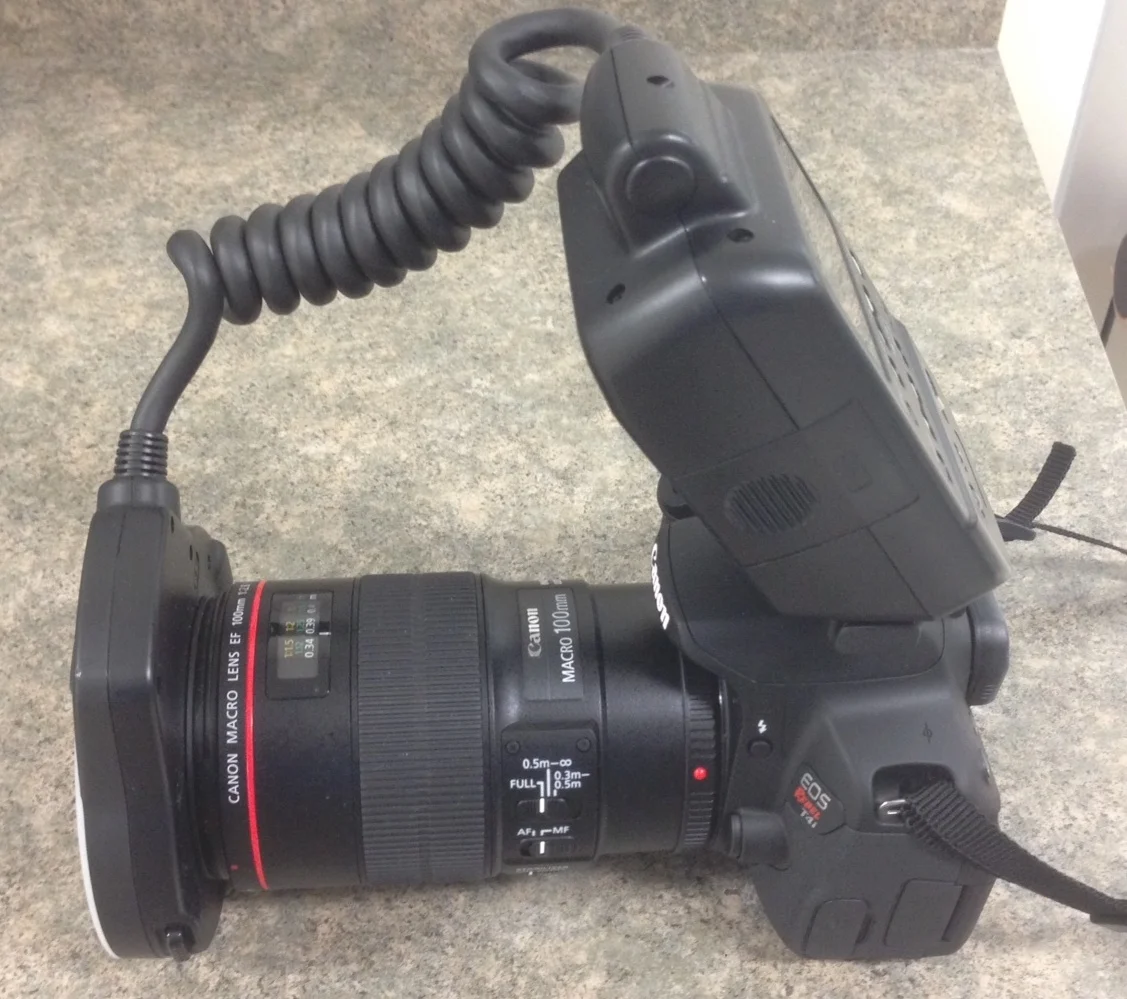Dental photography is very important to our profession in a number of ways. We take pictures to show our patients, to show off our great cases, to document pathology, to treatment plan, and many other reasons. Today, most dentists with a nice dental camera use either a Canon or Nikon DSLR with a giant macro lens and a ring flash. Most people equate a large camera with a good camera, but today I would like to show a modern alternative.
DSLR History
A particularly big DSLR with 100mm macro and ring flash.
When digital cameras first came out it was truly a break through. You could see your picture before developing any film. They where dubbed DSLR which stands for Digital Single Lens Reflex. They have a mirror that covers the sensor and flips up when you want to take a picture and flips down again to point the light into the viewfinder. This mirror takes up a lot of space and is one of the reasons the digital SLR of today has remained so big.
Leica mirror less interchangeable lens camera
Introduction of Mirrorless Interchangeable Lens Cameras
The first introduction of a popular mirror less interchangeable lens camera was Leica in 2006. It was a game changer because of the small form factor and powerful performance. Advancements in the genre and sensor developments have led the mirrorless interchangeable lens camera to be on par with DSLR's in all photo quality aspects.
Benefits of a Mirrorless Camera Over a DSLR for Dental Photography
Side by side comparison of an Olympus mirror less camera and a Canon DSLR. Notice the huge difference in the lens and body sizes.
A mirrorless camera has several advantages over a DSLR when it comes to dental photography. The most obvious difference is that a mirror less camera is smaller and weighs less. The difference between the two cameras featured today, the canon rebel and the Olympus OMD EM-5, is about 2 pounds and 2-4 inches, including all the lens and flashes needed. This is a huge difference, especially when holding the camera with one hand.
The sensor size of a mirrorless camera is usually smaller than a DSLR, they are so-called crop sensors. This has interesting benefits to macro photography. Cropped sensors have a magnification effect in relation to a full sized 35mm film space that is the standard that all lenses are judged on. So a 60mm macro lens on a cropped sensor may be equivalent to a 120mm sensor on full sized film space. This means it is double the magnification. Due to the crop it also has a greater depth of field, meaning more of the picture is in focus. This would allow the dental photographer to use a brighter f-stop (lower number) to let in more light and make you pictures even sharper. This would also allow a faster shutter speed and less blur, even with a shaky hand.
Because DSLRs have a mirror blocking the sensor, they typically force you to look through a view finder and not a live view screen in the back. This means that you have to move your entire face to wherever the camera is, to take a picture. For an extreme close-up you could be really hunching your back toward your patient's mouth. With mirror less cameras, you can see through a digital viewfinder or use the screen on the back of the camera. Many even have tilting screens to help you view the scene. This leads to more comfortable picture taking and even better pictures
One hand control of camera. The screen will tilt up or down to allow pictures help above or below the operator. The screen shows what picture the camera sensor will take.
Video can be something you may want to use if demonstrating a procedure, recording functional movements, or just for fun. Mirrorless cameras are capable of incredible video that can be accessed with a click of a button. Some DSLR's are not even capable of taking video and those that can often don't show accurate video on the display while taking them. It is also impossible to use the viewfinder when taking video on a DSLR.
Conclusion
Mirrorless cameras are the future of digital photography. They offer many benefits over traditional DSLRs and very little drawbacks. In the products section of perioimplantology blog I will include amazon links to suggested products to set up your own mirror less dental camera. There are many mirrorless cameras to choose from, but in this case I will post about the system I use myself; Olympus micro four thirds.
Example of picture taken with a mirror less camera.


